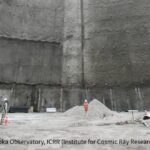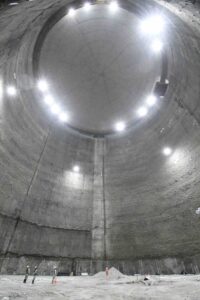
Excavation of the Colossal Cavern for Hyper-Kamiokande Completed

The main Hyper-Kamiokande cavern after excavation completed. Credits: Kamioka Observatory, ICRR (Institute for Cosmic Ray Research), The University of Tokyo
On July 31, 2025, the University of Tokyo completed excavation of the colossal cavern that will house the main detector volume of Hyper-Kamiokande, a next-generation, ultra-large water Cherenkov detector currently under construction in Hida City, Gifu, Japan.
Hyper-Kamiokande (Hyper-K) is a next-generation particle detector consisting of a gigantic water tank with a fiducial volume 8.4 times that of its predecessor, Super-Kamiokande, and is equipped with over 20,000 newly developed photodetectors. It is currently being constructed 600 meters underground beneath a mountain in Hida City, Gifu Prefecture, Japan, with the University of Tokyo leading the effort. In parallel, the High Energy Accelerator Research Organization (KEK) is leading the upgrade of the J-PARC neutrino beam and the construction of a new intermediate detector in Tokai Village, Ibaraki Prefecture. Through the combination of these efforts, the Hyper-Kamioande project aims to precisely measure neutrino properties and to search for proton decay, ultimately contributing to solving fundamental mysteries of the universe and testing the ideas of Grand Unified Theories. The Hyper-K project officially began in February 2020 with the allocation of its initial-year budget.
The Hyper-Kamiokande project is an international scientific research collaboration led by the University of Tokyo and the High Energy Accelerator Research Organization. As of July 2025, approximately 630 researchers from 22 countries are actively contributing to the project.
European institutes and companies are playing a large role in the construction and operation of the Hyper-Kamiokande experiment, with over 50% of the collaboration members from Europe leading the design, construction and installation of multiple elements of the various detectors of Hyper-Kamiokande.
More information
- Press release: https://www.icrr.u-tokyo.ac.jp/en/news/16770/
- Hyper-Kamiokande website: https://www-sk.icrr.u-tokyo.ac.jp/en/hk/



